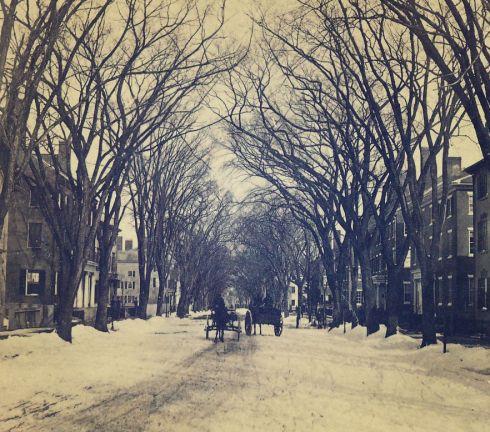Yesterday was a beautiful winter day with everyone out and about cleaning up after the Saturday snowstorm, which was not as bad north of Boston as it was to the south.The streets of Salem were clear by mid-morning, if not before (I was sleeping in), and people were engaged in their regular Sunday activities. There were Sunday street-hockey players out my front windows, and hungry birds out back.


I suddenly became curious about snow removal in the past–mostly because I didn’t want to go out and engage in my own snow removal in the present. I have–and have seen–quite a few historic photographs of winter scenes in Salem in the later nineteenth and early twentieth centuries, but none of them feature snow carts, snow plows, or snow removal. Salem has always been quite urban, and people needed to get around, how did they manage? What was the system then that so preoccupies us now? Both the New York Public Library and the Boston Public Library have quite a few photographs of various methods of snow removal in their collections, from simple shovel brigades to “snow rollers”–I’ve never seen anything like that for Salem: anyone out there have anything?


Chestnut and Lafayette Streets in the 1870s in stereoviews by Charles G. Fogg. Carriages on the snow—not even sleighs! But it’s not too deep here.


Chestnut Street in the 1890s, deeper snow, no signs of plowing–but these carriages do look like they are on blades. I’ve shown these before; they are from a family archive in the Schlesinger Library at Harvard.
My problem is that I don’t have any winter scenes of Washington or Essex Streets with tracks that needed to be cleared: Chestnut was and remains strictly residential. I still think people trudged around a lot more than we do now, however. Look at these two wonderful photographs of students from the Horace Mann “Training School” associated with the Salem State Normal School (now Salem State University, where I teach) and their teacher, visiting historic sites downtown in the snow.Look at her skirt: she’s not troubled by a little snow.

E.G. Merrill photographs of Horace Mann students, 1904, Salem State University Archives and Special Collections.
Like everything else, our toleration for snow in the streets changed with the automobile: we won’t settle for anything less than black the day after a snowstorm now. The wonderful book by Marblehead artist, photographer, and author Samuel Chamberlain, Salem in Four Seasons (1938) shows winter streets cleared for cars and pedestrians. And he agrees with me: some of Salem’s most beautiful moments are in winter, when few visitors see it (though a lot more now, fortunately).

Plowing Chestnut Street in the 1930s, from Samuel Chamberlain’s Salem in Four Seasons (1938).






January 9th, 2017 at 11:12 am
My father, who grew up in Salem in the late nineteen teens and twenties, said that snow was dealt with by packing it down using a horse-drawn pung loaded with stones, or with a horse-drawn snow roller. These were kept at the city stables on Bridge Street.
January 9th, 2017 at 11:42 am
Thanks, Richard! This is just the kind of information I am looking for–I have seen pictures of these snow rollers, but not in Salem unfortunately.
January 9th, 2017 at 12:32 pm
The only photos I have seen of a snow roller in use are from Aroostook County in the Twenties. There may be a film available from the Cole Transportation Museum.
January 9th, 2017 at 12:29 pm
I agree that people simply walked about more. I have been in Canmore, Canada in very cold and snowy conditions, they hardly ever plough the side streets and the locals just dress up warm and walk to the shops. In the big cities of the US I am sure it is the same. Whereas here in rural Illinois people sit peering out their windows, complaining for days, waiting for the snow plough to pass along the roads and then the friend with a truck to clear their drives so they can get their jeeps out of their garages and DRIVE three blocks to the shops. Walking or working in the snow is unheard of. I love those shots of the kids playing hockey in the streets.. c
January 9th, 2017 at 2:05 pm
In the early 1950’s in Hartford, Conn, snowy streets were still rolled and anyone who had a car had to install chains on their tires. Most people then were still using public transportation, though. People were fined if they hadn’t shoveled their sidewalk by 7am because most people were walking to school or to bus and trolley stops for work. NO exemptions! If you couldn’t shovel your walks you had to hire it done.
January 9th, 2017 at 3:35 pm
That’s a great rule in cities, JoAnn, though difficult to enforce. I walk to work down a busy street and often have to walk IN that street when there is snow piled up as several absentee landlords neglected to shovel their sidewalks.
January 9th, 2017 at 4:31 pm
I have a condo in Chelsea. The city is merciless about ticketing if the sidewalk is not shovelled within twelve hours of the storm ending. They issue fifty dollar tickets to every home or apartment/condo building in the better and worse parts of town.
January 9th, 2017 at 4:20 pm
I love the Sunday morning street hockey players! It’s so delightful to see them…something so charming and delightfully archaic about it.
January 9th, 2017 at 5:48 pm
They’ve been playing every Sunday since the 1970s, I think.
January 9th, 2017 at 8:29 pm
[…] via Trudging Along — streetsofsalem […]
January 9th, 2017 at 10:20 pm
[…] Trudging Along […]